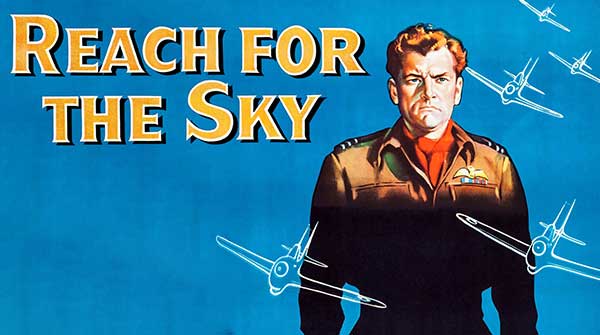A nostalgic journey through mid-century British movies
 When I was a child in Ireland, going to the small local cinema was an integral part of existence. From 1953 onwards, I saw at least 30 movies a year.
When I was a child in Ireland, going to the small local cinema was an integral part of existence. From 1953 onwards, I saw at least 30 movies a year.
Most of these were American. Indeed, the very idea of movies was associated with Hollywood, and anything emanating elsewhere was implicitly second-best. American movies had a flair and pizazz that the British couldn’t compete with. And Westerns – the favourite genre of everyone I knew – couldn’t credibly be made anywhere else.
Still, a substantial number of British productions found their way to our local screen. Some of them were actually pretty good.
 |
| Related Stories |
| Michael Caine is still going strong at 90
|
| Hollywood icons and the Second World War
|
| Maureen O’Hara, Ireland’s Queen of Technicolor
|
The Second World War being barely in the rear-view mirror, the period was an obvious source of material. And whereas Hollywood treatments invariably focused on American heroics, British pictures had British themes and heroes.
For instance, The Wooden Horse was based on the true story of a British POW escape. The Cruel Sea dealt with the Royal Navy’s challenges protecting Atlantic convoys from German U-boats. And The Dam Busters was all about the 1943 “bouncing bomb” raids on dams in Germany’s Ruhr valley.
But the most popular of all was probably Reach for the Sky. Based on the 1954 biography of double amputee aviator Douglas Bader, the story was told as an inspirational narrative of one man’s triumph over extreme adversity. Genuine courage and willpower notwithstanding, the real Bader could be difficult and unpleasant, quite at odds with the affably charming character portrayed on screen. As Bader wryly noted years later, people mistakenly “think I’m the dashing chap Kenneth More was.”
There were also some first-rate comedies, two of which birthed what became long-running series.
Faced with passing the time on a long rail journey, producer Betty Box picked up a copy of a Richard Gordon novel about young doctors in training and quickly saw the potential. Not everyone in the industry shared her enthusiasm, but Doctor in the House became a huge 1954 hit, eventually spawning six sequels.
Carry On Sergeant (1958) launched the other series: this time, there were 30 sequels showcasing a broad array of British comedic talent. With their uniquely British vibe, the Carry On films have been described as exemplifying a “comedy tradition that dates back to bawdy music halls and end-of-the-pier saucy postcards.”
Then there was Britain’s Hammer Films, a studio that more or less took over the horror genre. First up was 1957’s Curse of Frankenstein, followed by Dracula (1958) and The Mummy (1959). These were themes that Hollywood had done in black-and-white decades earlier, but the Hammer treatments surpassed them.
For my money, Hammer’s Dracula was the best film version ever made of Bram Stoker’s famous novel. Produced for what would now be considered a pittance, the combination of splendid casting, pacey directing, atmospheric storytelling and vivid Technicolor are very difficult to beat. Seeing it again several years ago, I was still impressed, although – thankfully – that viewing didn’t result in the sleepless night experienced by my 14-year-old self the first time around.
1950s British cinema also generated its own constellation of stars. They may not have possessed the cachet of Hollywood’s brightest, but they enjoyed loyal followings. The biggest were Jack Hawkins, Kenneth More and Dirk Bogarde.
In contrast to the working-class types that supplanted them in the 1960s, all three had a pronounced middle-class sensibility, the sort of men who would’ve been officers during the war. And indeed, they had been, all seeing active service.
With his stiff upper lip, craggy good looks, authoritative bearing and distinctive voice, Hawkins embodied sensible reliability; More was the good humoured decent chap who’d invariably see the brighter side of things; and Bogarde was the most complicated.
A closeted gay man in real life, Bogarde was elevated to romantic matinee idol status by 1954’s Doctor in the House. Although it wasn’t an image he particularly appreciated, he maintained it until the early 1960s.
However, 1961’s Victim – purportedly the first English-language film to use the word “homosexual” – saw him take a risk that Hawkins had turned down. Playing a married, repressed gay barrister, Bogarde embraced the role to the extent of rewriting dialogue to render a critical scene more intensely explicit.
After shepherding the decriminalization of private homosexuality between consenting adults through the House of Lords, the Earl of Arran wrote Bogarde commending him on “your courage in undertaking this difficult and potentially damaging part.” It had, the earl believed, contributed to shifting public opinion.
Troy Media columnist Pat Murphy casts a history buff’s eye at the goings-on in our world. Never cynical – well, perhaps a little bit.
For interview requests, click here.
The opinions expressed by our columnists and contributors are theirs alone and do not inherently or expressly reflect the views of our publication.
© Troy Media
Troy Media is an editorial content provider to media outlets and its own hosted community news outlets across Canada.

